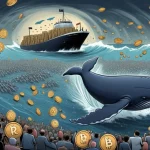XRP Whales Halt Profit-Taking After 300% Gains: Is a Price Crash Looming?

XRP Whales Hit Pause on Profit-Taking After 300% Gains—Is a Storm Brewing?
XRP whales, flush with over 300% profits from a historic rally, have momentarily stopped their massive sell-offs, but with a fresh 2% price dip to $2.1 and whispers of more distribution looming, the calm feels unnervingly fragile. Is this a breather for the market, or are we staring down the barrel of another volatile plunge?
- Whale Activity: Early XRP holders with 300%+ gains sold heavily post-November 2024 rally, slowed by March 2025, spiked to $68.8M/day in June, and paused again recently.
- Price Slip: XRP dropped 2% to $2.1, possibly reflecting earlier whale selling pressure.
- Big Question: Does this pause signal exhausted selling, or is it just a temporary lull before more chaos?
Tracking the XRP Whale Sell-Off: A Timeline of Profit-Taking
Let’s cut through the noise and get to the raw data. On-chain analytics from Glassnode paint a vivid picture of XRP holder behavior, specifically a group of investors who struck gold by buying in before the explosive November 2024 price surge. These early adopters, often called “whales” due to their oversized holdings (think of them as the Wall Street titans of crypto, whose moves can swing entire markets), saw XRP climb from under $0.60 to over $2, netting them profits exceeding 300%. Their response? Cash out big time. Heavy selling started right after the rally, continued into early 2025, and only tapered off by March 2025, giving the market a fleeting moment of stability. For more on these XRP whale profit-taking trends, the data speaks volumes.
But don’t get too comfortable. By early June 2025, these whales were back in action, dumping XRP at a staggering rate of $68.8 million per day (based on a 7-day Simple Moving Average, a metric that smooths out daily spikes for a clearer trend). Now, the latest figures show another slowdown in this selling spree. For those new to the game, profit-taking is when investors sell their stash to lock in gains, and Glassnode’s “Realized Profit” metric tracks this by comparing buy and sell prices. When whales unload massive volumes, the market gets flooded with supply, often pushing prices down as smaller players scramble or demand lags behind. XRP’s recent 2% tumble to $2.1 (per TradingView data as of late June 2025) might just be the aftershock of these earlier waves, though pinning exact cause-and-effect in crypto is like predicting the weather in a tornado. Curious about broader profit-taking patterns impacting the market in 2025? The numbers are eye-opening.
“In early June, they began realizing profits at a pace of $68.8M per day (7D-SMA), signaling a wave of distribution by early holders.” – Glassnode
What Fueled XRP’s Meteoric Rise—and the Fallout?
Understanding why these whales even have such fat profits to take means rewinding to late 2024. XRP, the token tied to Ripple, has long been a lightning rod in crypto circles due to its perceived centralization—a far cry from Bitcoin’s decentralized purity. But last year, it caught a massive tailwind. Legal clarity in Ripple’s drawn-out SEC lawsuit, which debated whether XRP counts as a security, eased investor fears. On top of that, spot ETF filings from heavyweights like WisdomTree and Bitwise sparked hype, driving XRP’s price to dizzying heights. The result? A market where over 70% of XRP’s realized market cap—basically the total value of coins based on their last traded price—was formed post-2024, according to CoinTelegraph. That’s a top-heavy structure, folks. Newer holders sit on slimmer margins, while early whales hold the power to rock the boat with every sell order. For a deeper dive into the price impact of early holder selling during the November 2024 rally, the insights are telling.
Fast forward to now, and the pause in whale selling raises a critical uncertainty: are they done, or just catching their breath? Glassnode’s data on the Spent Output Profit Ratio (SOPR), a metric showing whether coins are sold at profit or loss, reveals a troubling split. While the oldest, most profitable holders are cashing out, newer investors—those holding for 3 to 6 months—are selling at breakeven or slight losses. That’s a shaky foundation for price stability. CoinTelegraph goes further, drawing a grim comparison to XRP’s 2017 cycle, where similar profit-taking by high-margin holders foreshadowed a brutal 90% crash. Their analysts flag technical patterns like a descending triangle on the charts, warning of a potential 35% drop to $1.35–$1.60 if sentiment sours.
Bullish Signals or False Hope? XRP’s Mixed Bag
Yet, not every signal screams doom. CoinCentral points out XRP’s grit, holding above $2 despite the whale onslaught. They highlight a jaw-dropping 490% surge in daily active addresses since cycle lows, suggesting sustained user interest or demand. If XRP punches through $2.40, they argue, we could see it test $2.60 or even $3. Beyond price, the XRP Ledger (XRPL) itself offers some bragging rights. With a transaction throughput of 9.71 transactions per second (TPS) and over 13.91 million XRP burned historically through fees (about 3.8K daily), per Reddit data, it’s got a deflationary edge Bitcoiners can respect. Unlike Bitcoin’s energy-hungry Proof-of-Work, XRPL uses a consensus protocol that’s faster and cheaper, positioning it for niches like cross-border payments—Ripple’s bread and butter via bank partnerships. Community perspectives on XRP whale activity and market sentiment in June 2025 also reflect this mixed optimism.
But let’s not get starry-eyed. Reddit chatter flags a glaring red alert: XRP’s Network Value to Transactions (NVT) ratio, a kind of price-to-earnings gauge for crypto that compares market cap to on-chain transaction volume, has skyrocketed to 796.15, up over 314% recently. Translation? The price might be running on fumes if actual network usage doesn’t catch up. Add to that conflicting retail signals—active addresses are up, but trade counts are down—and the market picture is murkier than a swamp. Are we seeing genuine adoption, or just speculative noise? For further discussion on how whale selling affects XRP market stability, community insights add valuable context.
Key Questions Unpacked: Navigating XRP’s Uncertain Waters
- What does whale profit-taking mean for XRP’s near-term outlook?
It’s largely bearish for now. Large sell-offs increase supply, often suppressing price, as seen with the recent 2% dip to $2.1. Until demand absorbs this pressure, downside risks linger. - Is the current pause in selling a positive sign for XRP?
Not necessarily. It could mean selling pressure is easing, but historical patterns—like the 2017 crash—suggest this might just be a brief intermission before more distribution. - How does XRP’s market structure affect its stability?
With 70% of its realized market cap formed after 2024, it’s heavily weighted toward newer, less entrenched holders. This makes XRP more vulnerable to whale-driven swings compared to Bitcoin’s more distributed network. - Can XRP’s technical strengths counter market volatility?
XRPL’s high TPS and token-burning mechanism are impressive, but price volatility often overshadows tech fundamentals in the short term. Utility alone won’t shield it from whale moves. - Should investors buy into XRP’s rally potential?
Caution is key. High NVT ratios hint at overvaluation, and historical crashes loom as warnings. Legal wins and ETF hype fuel optimism, but a 35% drop isn’t off the table if sentiment flips.
A Bitcoin Maximalist Lens: Centralization vs. Disruption
As champions of decentralization, we can’t ignore the elephant in the room: XRP’s volatility and whale-driven market are stark reminders of why Bitcoin’s model reigns supreme. Sure, altcoins like XRP carve out niches—Ripple’s focus on remittances and bank tie-ups tackles use cases Bitcoin doesn’t prioritize. And we’re all for experiments that accelerate financial disruption, even if they’re messy. But when a handful of early holders can jolt the price this much, it exposes the fragility of centralized systems. Bitcoin’s strength is its resilience to such concentrated power plays; XRP often feels like a high-roller’s gamble, not a bedrock for freedom or privacy. To explore more on how whale profit-taking impacts XRP’s price, online discussions offer raw perspectives.
That said, let’s give credit where it’s due. XRP’s story isn’t just a cautionary tale—it’s also a testament to how altcoins push boundaries, even if they stumble. Ripple’s argument for centralization enabling scalability and real-world adoption isn’t baseless; it’s landed them partnerships Bitcoin could never dream of. Still, for every legal victory or ETF rumor pumping XRP, there’s the nagging risk of regulatory backfire or a market correction if whales keep dumping. Compare that to Bitcoin’s slow-and-steady dominance, especially during bull cycles when altcoins often bleed out, and the contrast is glaring.
Broader Implications: Altcoins, Whales, and the Crypto Game
Zooming out, XRP’s whale saga mirrors a recurring theme in altcoin territory: flashy pumps, unique promises, but shaky ground when big players cash out. Historically, XRP isn’t alone—look at Litecoin or Cardano during past cycles, where early holder sell-offs often signaled local tops. Retail sentiment, too, plays a role. Social media buzz and exchange inflows suggest smaller investors are caught between FOMO and fear, often lagging behind whale moves. Glassnode data on broader altcoin markets shows similar patterns of distribution when profits hit extreme levels, hinting XRP’s drama isn’t unique—just louder due to its polarizing status. For a comprehensive look at whale profit-taking trends using 2025 Glassnode data, the analysis is worth a read.
Then there’s the Bitcoin dominance factor. If BTC rallies hard in 2025, as some on-chain metrics like stock-to-flow models suggest, altcoins like XRP could face capital outflows as investors flock to the safer bet. It’s a dynamic we’ve seen before—altcoin season thrives until Bitcoin flexes its muscle. For now, XRP’s fate hangs on whether its fundamentals (like XRPL’s tech) and catalysts (legal clarity, ETF approvals) can outweigh whale pressure and valuation concerns. Check out this detailed analysis of XRP price trends and whale activity for more on potential upside scenarios.
Final Thoughts: Eyes on Data, Not Hype
XRP’s journey is a microcosm of the altcoin gamble—high highs, gut-punch lows, and a constant tug-of-war between innovation and risk. We’re rooting for disruption of the financial status quo, no question. But let’s not drink the Kool-Aid of unchecked optimism. Whales pausing their sell-off might offer a glimmer of hope, or it might just be the quiet before a 35% nosedive. Keep your focus on Glassnode’s on-chain signals, XRPL’s usage stats, and hard data—not the wild price predictions littering X spaces or Telegram. This space is about long-term freedom, privacy, and decentralization, not chasing a quick buck off a whale’s scraps. So, are altcoins like XRP a vital experiment in reshaping finance, or a risky detour from Bitcoin’s mission? That’s the trade-off worth wrestling with as we watch this unfold.



